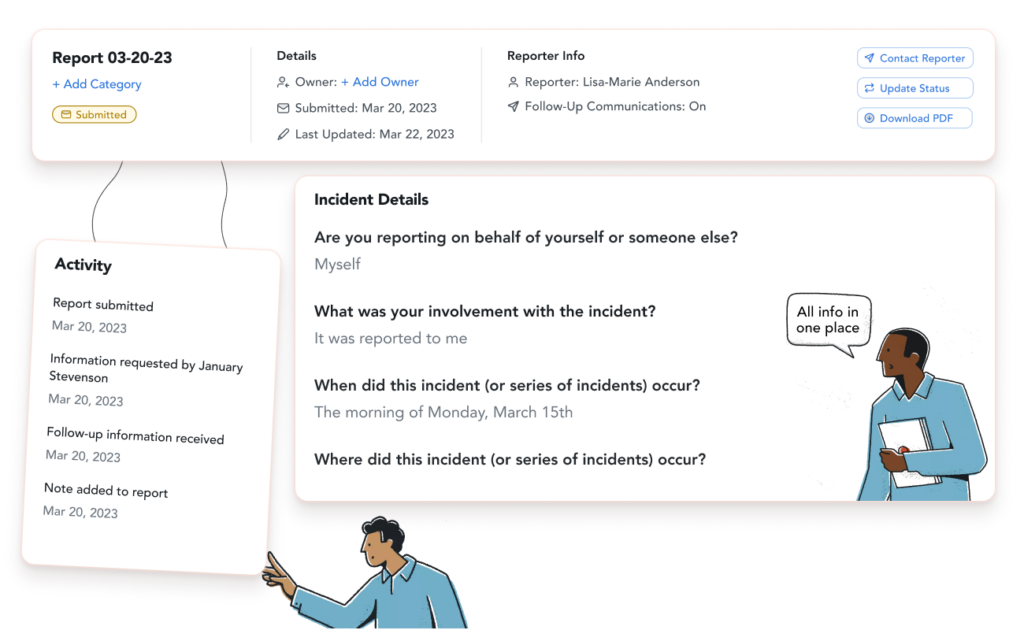So you’ve decided to introduce an employee hotline at your workplace — what great news! Your employees are about to reap the benefits of a feedback-forward culture, and you’ll be rich in insights that make any whiff of a toxic workplace environment a thing of the past.
…right?
Well, that’s the goal, of course. But the reality is that the only thing worse than not having a hotline at all is dedicating the time, energy, and resources toward researching, selecting, purchasing, and implementing a hotline… only to have it languish, unused.
If this has been your experience in the past, you’re not alone. There could be a whole slew of reasons why folks aren’t taking advantage of a new resource: maybe they don’t know where to find it, or how to use it, they’re worried about getting someone in trouble or getting in trouble themselves, or they don’t feel the psychological safety required to speak up in the first place.
These are all valid concerns (so valid, in fact, that we built our own Employee Hotline and Case Management Tool to address them), so we reached out to our own VP of People, Melanie Naranjo, to help us tackle them one by one.
What is an employee hotline?
Let’s start at the beginning. What exactly is an employee hotline?
An employee hotline is a pipeline that transports feedback, concerns, and reports of workplace misconduct from the employees experiencing these issues up to the folks who can do something to resolve them — typically the HR or People Team.
Every reporting tool is different, but many allow for either anonymous or attributed reporting, and the best tools also serve as a centralized hub for long-term case management.

How do I know if my company needs an employee hotline?
At Ethena, we believe feedback is a gift, so we’d never talk you out of implementing an employee hotline, no matter your company size. But if you ask Melanie, there comes a point, somewhere around the 50 employees mark, where word of mouth just doesn’t cut it anymore.
For whatever reason, the flow of information evolves and changes around that milestone, which makes it a good opportunity to put some information-gathering systems like employee surveys and an employee hotline in place. That way, you can maintain a big-picture view of the organization’s health and overall vibe even without frequent touch points with every single employee.
Why is a case management tool preferable to a standalone whistleblower hotline?
This is the topic you don’t want to get us started on at a networking event, so we’ll try to keep it brief!
Whistleblower hotlines are great on paper… and sometimes, that’s where it ends. According to a recent compliance risk benchmarking survey published by KPMG, hotlines are missing the mark when it comes to implementation. To quote Radical Compliance:
“Essentially, the findings are these: that companies spend more time measuring employees’ awareness of the whistleblower hotline, but not necessarily employees’ comfort with actually using the hotline. That might be a significant mistake, because employees are more concerned about whether they can trust the whole internal reporting process rather than the mechanics of exactly how one is supposed to file a report.”
Radical Compliance

How to effectively roll out an employee hotline and case management tool
Given those findings, how do we recommend maximizing effectiveness while lowering the barriers to entry? According to Melanie and our broader Ethena team, it’s a simple, three-step process.
1. Promote the employee hotline and make sure it’s accessible.
Like we said at the top, if no one knows about your tool or how to get to it, do you really even have one? Get the word out in multiple ways, location, and with buy-in at levels up, down, and across the org chart.
- How: Educate folks early and often, starting with onboarding and other relevant trainings.
- Where: Place a link to the employee hotline in accessible areas that are frequented by employees — think company documents, wikis, and on Slack, Teams, or similar platforms.
- When: Socialize periodically during the year. This one’s a big one, as our research for this project found the majority of employees wouldn’t know where to go or what to do if an incident occurred. Try linking to the hotline when you promote office hours, roll out your annual harassment prevention training, and at the start of each year when reminding employees more generally about the company resources on offer.
- Who: Train people leaders about it. We heard that when in doubt, reporters tend to bring issues to their managers as a first stop, so there’s a great opportunity to work case management tools education into your management training. That way, if something comes up during a coaching session, a manager is equipped to either report by proxy or offer instruction on how to use the tool to escalate independently.
2. Address key concerns head-on.
Let’s face it, there are a lot of (perfectly valid) concerns that folks may have when it comes to reporting. For that reason, we recommend creating an FAQ doc that’s easily accessible and shared alongside the hotline link so that a lack of information is less likely to be an obstacle.
You know your own workforce best, but here are some topics we believe are worth covering:
- Anonymity: The vast majority of reporters want the option to keep their identity hidden, even with follow-up communications. (Our Employee Hotline & Case Management tool allows for this, which saves you some time in drafting your FAQ doc!)
- Retaliation: Reporters will want to know they’re protected from retaliation — and what to do if it occurs.
- Consequences: Share information on your organization’s investigation process; specifically, what happens to the person(s) they report.
- Expectations: Reporters often second-guess themselves in the wake of an incident and will want to know exactly which types of issues should be reported.
- Buy-in: It can take substantial emotional effort for an employee to use the hotline if they see something iffy, so folks will need to know that the process is worth it and has leadership and organizational buy-in.

3. Train employees on the hotline and case management process at your company.
Providing specifics on what to expect is not only helpful for the reporter, it’s necessary on the admin side. Without clear communication, you risk detrimental assumptions like the reporter feeling as though their issue isn’t being taken seriously, or fearing that no action will be taken. If you want to stop those fears before they start, consider offering transparency around:
- The pros and cons of reporting anonymously vs. disclosing your name
- What investigations look like
- Who is typically involved in the investigation process
- Realistic expectations about outcomes; specifically, what can and can’t be shared with the reporter
Ready to roll out a hotline and case management tool your employees will actually use?
With all this information at your fingertips, we’re confident that you can boost employee leveraging of any hotline and case management tool — but of course, we’re partial to ours.
Get started with Ethena’s Employee Hotline & Case Management tools today; or if you have any questions, talk with a member of our sales team!










